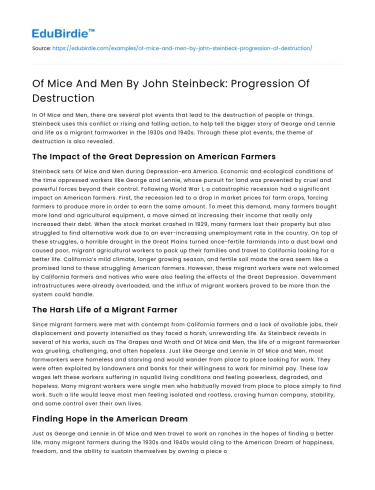In Of Mice and Men, there are several plot events that lead to the destruction of people or things. Steinbeck uses this conflict or rising and falling action, to help tell the bigger story of George and Lennie and life as a migrant farmworker in the 1930s and 1940s. Through these plot events, the theme of destruction is also revealed.
The Impact of the Great Depression on American Farmers
Steinbeck sets Of Mice and Men during Depression-era America. Economic and ecological conditions of the time oppressed workers like George and Lennie, whose pursuit for land was prevented by cruel and powerful forces beyond their control. Following World War I, a catastrophic recession had a significant impact on American farmers. First, the recession led to a drop in market prices for farm crops, forcing farmers to produce more in order to earn the same amount. To meet this demand, many farmers bought more land and agricultural equipment, a move aimed at increasing their income that really only increased their debt. When the stock market crashed in 1929, many farmers lost their property but also struggled to find alternative work due to an ever-increasing unemployment rate in the country. On top of these struggles, a horrible drought in the Great Plains turned once-fertile farmlands into a dust bowl and caused poor, migrant agricultural workers to pack up their families and travel to California looking for a better life. California’s mild climate, longer growing season, and fertile soil made the area seem like a promised land to these struggling American farmers. However, these migrant workers were not welcomed by California farmers and natives who were also feeling the effects of the Great Depression. Government infrastructures were already overloaded, and the influx of migrant workers proved to be more than the system could handle.
Save your time!
We can take care of your essay
- Proper editing and formatting
- Free revision, title page, and bibliography
- Flexible prices and money-back guarantee
The Harsh Life of a Migrant Farmer
Since migrant farmers were met with contempt from California farmers and a lack of available jobs, their displacement and poverty intensified as they faced a harsh, unrewarding life. As Steinbeck reveals in several of his works, such as The Grapes and Wrath and Of Mice and Men, the life of a migrant farmworker was grueling, challenging, and often hopeless. Just like George and Lennie in Of Mice and Men, most farmworkers were homeless and starving and would wander from place to place looking for work. They were often exploited by landowners and banks for their willingness to work for minimal pay. These low wages left these workers suffering in squalid living conditions and feeling powerless, degraded, and hopeless. Many migrant workers were single men who habitually moved from place to place simply to find work. Such a life would leave most men feeling isolated and rootless, craving human company, stability, and some control over their own lives.
Finding Hope in the American Dream
Just as George and Lennie in Of Mice and Men travel to work on ranches in the hopes of finding a better life, many migrant farmers during the 1930s and 1940s would cling to the American Dream of happiness, freedom, and the ability to sustain themselves by owning a piece of land. While very few farm workers ever attained this dream, its mere presence in their minds would act as a form of hope or reason to keep going. The long-held conviction that the West was the Promised Land, a place to get a fresh start and find concrete employment, also added to this notion of the American Dream. The American Dream was often dangled in front of migrant farmworkers only to be cruelly yanked away by circumstances out of their control. For example, flyers advertising the need for farmworkers were distributed in areas hit hard by unemployment, influencing workers to move westward only to find too many workers and not enough jobs. In addition, the establishment of Route 66, one of America’s original highways, paralleled the westward movement of the migrant workers, making the trip seem more possible and hopeful for more workers. Ultimately, there was power in this shared dream and equal power in its failure to materialize.
Steinbeck’s Social Protest
Born in 1902, John Steinbeck grew up in Salinas, California, one of the state’s richest agricultural valleys, and spent his summers as a ranch worker, listening to stories and observing the lives of the working man. So, when the economic crash of the Great Depression directly affected the farmworkers of the American West, Steinbeck felt disgusted by the terrible suffering of the struggling ranch workers around him. His belief that landowners and bankers were partly responsible due to their exploitation of the cheap labor these workers provided led Steinbeck to write about this topic, exposing its reality to the world. Some of Steinbeck’s best-known works deal with the struggle of the poor, migrant workers, and Depression-era farmers, detailing the grueling life they faced. In Of Mice and Men, Steinbeck focuses on the working man’s dilemma, detailing the clash between a powerless worker, Lennie, and his elite oppressor, Curley. Through this scene, Steinbeck makes a social protest statement about the role that indifferent, cruel landowners and bankers played in migrant workers’ suffering. Through writing Of Mice and Men and The Grapes of Wrath, Steinbeck helped to persuade political leaders to provide more aid to people left most impoverished by the Depression. Steinbeck was clearly influenced by his own experiences with the farmworkers of the American West, which led him to write novels that influenced understanding and change for these struggling agricultural workers.






 Stuck on your essay?
Stuck on your essay?

